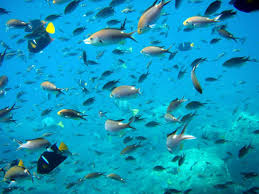In food production, a vital role is undertaken by the aquaculture or fishing sectors. Fisheries have a major contribution to agricultural exports and nutritional security. Totally 15 million people were involved in fishery activities so it is clear that this sector provides people secure employment and livelihood. The National Fisheries Development Board (NFDB) was initiated by our Indian Government to maintain this sector in a good manner. It promotes the production of fish and enhances the infrastructure of fisheries. Through NFDB, a central scheme called Blue Revolution was initiated in the year 2015 by Hiralal Chaudhri.

Blue Revolution
Blue revolution is an integrated Government sponsored scheme that supports the development of fishing units. It covers various activities which are multi-dimensional. Blue revolution is related to fish production and increases the productivity level of marine aquaculture and inland aquaculture. The blue revolution was initiated by Hiralal Chaudhri, who is known as the father of the blue revolution.
In the initial stages of 1980, there was a depletion in fish production due to improper maintenance. And gradually, the aquaculture productivity increased by 50%. The production of seaweeds, shellfish, and fish were raised to 5.8% in the year 2017. Aquaculture supplies fish and increases global consumption to 3.1% each year after the commencement of the Blue revolution.
Objectives of the Blue Revolution
The main objectives of the blue revolution are to increase the production of fish and the sustainability of aquaculture. Blue revolution supports the security of nutrition and food. It enhances the employment and economic prosperity of the people, especially farmers. The earnings from the exports were very high. Blue revolution also focuses on environmental concerns and bio-security.
Components of the Blue Revolution
- National Scheme of Welfare of Fishermen
- Inland Fisheries and Aquaculture Development
- Marine Fisheries, Infrastructure, and Post-Harvest Operations Development
- Fisheries Sector Institutional Arrangement
- Monitoring, Control, and Surveillance and other need-based Interventions
- Strengthening of Database & Geographical Information System of the Fisheries Sector
- National Fisheries Development Board with its activities
- National Scheme of Welfare of Fishermen
Importance of the Blue Revolution
Blue revolution plays a major role in developing the economy of fishers and farmers. It helps in the reduction of poverty and elevates the livelihoods of people who are depending on the fishery sector. It provides better employment and a stable income. Through aquaculture, the rural people get income from the production of different kinds of seafood. Many fishing practices yield different income ranges. Hence, the income may vary in several ranges depending on the production, demand, and types of activities they are involved in.
The blue revolution found its contribution to the development and management of freshwater aquaculture. The term ‘Aquaculture’ includes inland and marine farming. It supplies fish at a higher rate for human consumption. But the major disadvantages of aquaculture are water pollution and over intensification challenges.
Apart from providing income security, the blue revolution also provides food and nutrient security. It is helpful for the people living in rural areas and low-income nations. The sustainability of aquaculture reliably increases the fish supply. Aquaculture reduced the prices of the produced species that made them affordable for the people to get. The low price and continuous supply improved food production in insecure regions. Humans consume fish as it is a major source of omega-3 fatty acids, iron, calcium, vitamin D, and iodine. It also contains significant proteins. The blue revolution increased consumption, reduced the production price, and threatened nutrition and food security.
FAQs
Central Financial Assistance?
Board patterns of central funding for new projects are made under four components namely National Fisheries Development Board (NFDB), Infrastructure and Post-Harvest Operations, Development of Inland Fisheries and Aquaculture, Development of Marine Fisheries and National Scheme on Welfare of Fisherman. The assistance provided by the above-mentioned departments is listed below.
- 50% of the project or unit cost would be provided for general States, and the rest would be funded by the State agencies or organization, corporation, boards, federations, private entrepreneurs, fisheries cooperatives and individual beneficiaries.
- 80% of the project or unit cost would be provided for North-Eastern/Hilly States, and the rest would be funded by State agencies or organisations, cooperatives, individual beneficiaries etc.
- 100% for projects that are directly implemented by the Government of India through its institutes/organizations and Union Territories.
Projects that are under the remaining three components such as the strengthening of database and institutional arrangement for the fisheries sector, geographical information system of the fisheries sector and Monitoring, Control and Surveillance (MCS) and other need-based interventions would be granted with 100% central funding. Entrepreneurs, individual beneficiaries, and cooperatives/collectives of the Union Territories would also be granted central financial assistance concerning such beneficiaries in the General States.
Matsya Sampada Yojana?
Matsya Samapada Yojana was announced by the Finance Minister Nirmala Sitharaman during the Financial Budget 2019-20. The Government aims to promote aquaculture to benefit all fishermen with social security and to expand the coverage for accident insurance.